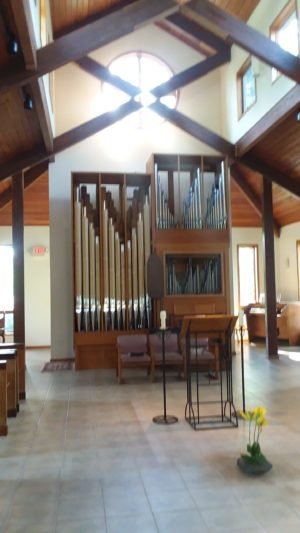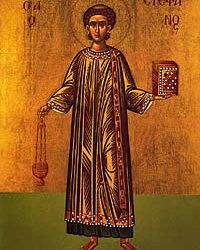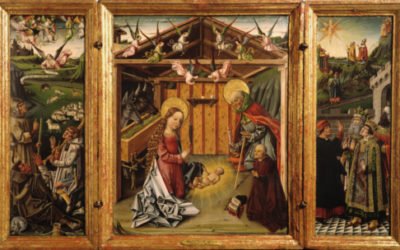Organ Thursday
Organ Thursday – Nerdy details on the new Wigton pipe organ
In each of the three organ divisions (Pedal on the left, Great on top on the right, Swell below), the casework and pipe display is divided into three sections. This reflects the layout of the windchests. For those who are interested, here’s more about that.
From the earliest organ we know of, ancient Rome’s “hydraulis”, it has been important to provide steady wind to the pipes. It remains a primary goal of every organ builder to supply steady wind to maintain consistent pitch and sound quality. Pipes are not usually arranged from largest to smallest as too many large pipes might play together at one end of the windchest and draw too much air, making the pitch sag. Pipes are often arranged by alternating the largest pipes between two sides of the organ; low C on the left, C-sharp on the right; D on the left, D-sharp on the right, etc. Sometimes builders divide the pipes in four sections to further assist in stabilizing wind. In our case, they are divided into three parts. In the Pedal, for example, low C is at the far left, the center starts with low D on the left side, and the right section places low C-sharp at the far right side; this can be seen in the photo. This pattern continues through the remaining span of the stop. The other pipes, not visible behind the front pipes, are lined up in the same order; for example, all the low C’s from each stop sit on the same windchest “channel”. By this design the large pipes that draw the most wind are spread about to help keep the wind supply steady and our musical ears satisfied with good tuning.
Pipes can be arranged in various orders, especially on electric-action chests, but in tracker-action organs (with “slider” chests as we have) there are more limits to pipe placement. The pipe arrangement is dictated by mechanical needs, not the whims of a visual designer. This is a simpler mechanism which results in better performance and longer service.
Tonal finishing is not complete; the swell shades are not up, and the two reed stops have not yet arrived, but the organ is used for hymns at the Sunday mass. Dr. George Weckman, major donor to the instrument and also a fine organist, will visit soon and he hopes to play some short programs. Watch for details. A recital series will commence when the organ is ready. Further programs will be announced later. Dedication will take place in the fall; stay tuned! ~djs



